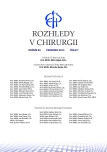-
Medical journals
- Career
Endoscopic endonasal treatment of cerebrospinal fluid leak caused by clival fracture – a case report
Authors: M. Májovský; D. Netuka; V. Masopust; V. Beneš
Authors‘ workplace: Neurochirurgická a neuroonkologická klinika 1. LF a ÚVN Praha, prof. MUDr. V. Beneš, DrSc.
Published in: Rozhl. Chir., 2015, roč. 94, č. 7, s. 297-300.
Category: Case Report
Overview
Introduction:
Clivus is a central structure of the skull base located in the vicinity of the brainstem and vital brain vessels. Clival fractures are usually caused by a high-energy trauma. Cerebrospinal fluid leak is one of the most common complications.Case report:
A middle-aged male sustained a mild head trauma, followed by a nasal cerebrospinal fluid leak. CT scan revealed the massive pneumocephalus and the fracture of the clivus in the posterior wall of the sphenoidal sinus. We performed an endoscopic endonasal surgery to seal the defect.Discussion:
Pneumatization of a sphenoidal sinus shows high variability. In the presented case, extreme pneumatization of the sinuses was combined with the gracile clivus, which was the predisposing factor for fracture. Traumatic cerebrospinal fluid leak carries the risk of intracranial hypotension and meningitis. Microscopic transseptal management is the classical surgical approach, while endoscopy provides the modern miniinvasive option.Conclusion:
Endoscopic endonasal treatment of traumatic cerebrospinal fluid leak is the treatment of choice for the clival fractures.Key words:
skullbase fracture – neurosurgery – endoscopy
Sources
1. Lu Y, Pan J, Qi S, et al. Pneumatization of the sphenoid sinus in Chinese: the differences from caucasian and its application in the extended transsphenoidal approach. J Anat 2011;219 : 132−42.
2. Hamid O, El Fiky L, Hassan O, et al. Anatomic variations of the sphenoid sinus and their impact on trans-sphenoid pituitary surgery. Skull Base 2008;18 : 9−15.
3. Bu GX. Variation of sphenoidal sinuses in relation to sella turcica. Chin Med J (Engl) 1990;103 : 324−5.
4. Keir J. Why do we have paranasal sinuses? J Laryngol Otol 2009;123 : 4−8.
5. Kellman RM, Schmidt C. The paranasal sinuses as a protective crumple zone for the orbit. Laryngoscope 2009;119 : 1682−90.
6. Lee TS, Kellman R, Darling A. Crumple zone effect of nasal cavity and paranasal sinuses on posterior cranial fossa. Laryngoscope 2014;124 : 2241−6.
7. Ochalski PG, Spiro RM, Fabio A, et al. Fractures of the clivus: a contemporary series in the computed tomography era. Neurosurgery 2009;65 : 1063−9.
8. de Melo PM, Kadri PA, de Oliveira JG, et al. Cervical epidural haematoma with clivus fracture: case report. Arq Neuropsiquiatr 2003;61 : 499−502.
9. Wang E. Clival fracture with basilar artery laceration. Curr Probl Diagn Radiol 2012; 41 : 114−5.
10. Sato S, Iida H, Hirayama H, et al. Traumatic basilar artery occlusion caused by a fracture of the clivus--case report. Neurol Med Chir (Tokyo) 2001;41 : 541−4.
11. Masopust V, Plas J. Longitudinální zlomenina klivu. Rozhl Chir 1998;77 : 385−8.
12. Friedman JA, Ebersold MJ, Quast LM. Post-traumatic cerebrospinal fluid leakage. World J Surg 2001;25 : 1062–6.
13. Bachmann-Harildstad G. Diagnostic values of beta-2 transferrin and beta-trace protein as markers for cerebrospinal fluid fistula. Rhinology 2008;46 : 82−5.
14. Marentette LJ, Valentino J. Traumatic anterior fossa cerebrospinal fluid fistulae and craniofacial considerations. Otolaryngol Clin North Am 1991;24 : 151–63.
15. Ratilal BO, Costa J, Sampaio C, et al. Antibiotic prophylaxis for preventing meningitis in patients with basilar skull fractures. Cochrane Database Syst Rev 2011;48 : 1025−32.
16. Ray BS, Bergland RM. Cerebrospinal fluid fistula: clinical aspects, techniques of localization and methods of closure. J Neurosurg 1967;30 : 399–405
Labels
Surgery Orthopaedics Trauma surgery
Article was published inPerspectives in Surgery

2015 Issue 7-
All articles in this issue
- Heterotopic mesenteric ossification
- Rectal cancer. More or less radiation?
- Pruritus ani
- Current status in the treatment of rectal cancer in the Czech Republic regarding the rate of complete pathological response after neoadjuvant therapy – PATOD C20 study 2011−2012
- SentiMag – the magnetic detection system of sentinel lymph nodes in breast cancer
- Acute bleeding into the GI tract – A surgical diagnosis?
- Endoscopic endonasal treatment of cerebrospinal fluid leak caused by clival fracture – a case report
- Critical complications of intestinal tuberculosis − a case report
- Perspectives in Surgery
- Journal archive
- Current issue
- Online only
- About the journal
Most read in this issue- Pruritus ani
- SentiMag – the magnetic detection system of sentinel lymph nodes in breast cancer
- Heterotopic mesenteric ossification
- Endoscopic endonasal treatment of cerebrospinal fluid leak caused by clival fracture – a case report
Login#ADS_BOTTOM_SCRIPTS#Forgotten passwordEnter the email address that you registered with. We will send you instructions on how to set a new password.
- Career

